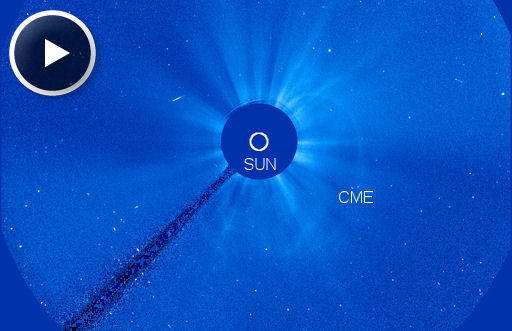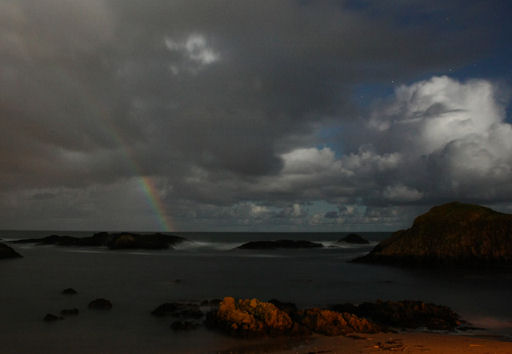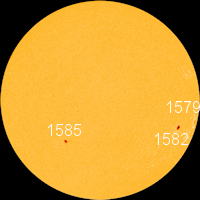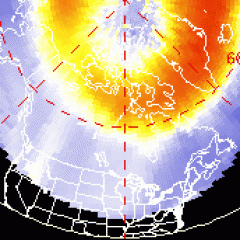DRACONID METEOR SHOWER: The notoroiusly unpredictable Draconid meteor shower peaks this year on the night of Oct. 7-8. In most years, the Draconids come and go with a barely noticable peak of 10 or so meteors per hour. Occasionally, however, Earth passes through a dense clump of debris from parent comet 21P/Giacobini-Zinner and a meteor storm erupts. Just last year, Europeans witnessed a faint but furious outburst of 600 per hour. There is no reason to believe that 2012 is a "storm year." Nevertheless, northern hemisphere sky watchers are encouraged to be alert for slow-moving Draconids on Sunday night.
EARTH-DIRECTED CME: Magnetic fields near sunspot AR1582 slowly erupted on Oct 5th sparking a B7-class solar flare and hurling a CME toward Earth. The Solar and Heliosphere Observatory (SOHO) captured this image of the expanding cloud:
Although Earth is in the line of fire, it won't be a direct hit. Instead, the CME will deliver a glancing blow to our planet's magnetic field. NOAA forecasters estimate a 20% chance of polar geomagnetic storms when the cloud arrives on Oct. 8th. High-latitude sky watchers should be alert for auroras especially during the hours around local midnight. Aurora alerts: text, voice
A RAINBOW AT NIGHT: Everyone has seen a rainbow during the day. Bright sunlight bounces off raindrops to produce a colorful arc of red, green and blue. But what about at night? Without sunlight, a rainbow would seem to be impossible. Nevertheless, Martin McKenna saw one on the night of Oct. 3rd over Ballintoy Harbour in Northern Ireland:
This is a type of rainbow called a "moonbow," formed by the light of the Moon instead of the sun.
"I was fortunate enough to catch these rare moonbows over the surreal moonlit Atlantic Ocean at Ballintoy Harbour," says McKenna. "The gibbous moon rising in the east produced enough light to illuminate the off-shore showers, which produced a near complete moonbow. I could see red, yellow, and white colours with the naked eye. The scene looked amazing over the ancient coastline."

![]()
Solar wind
speed: 321.1 km/sec
density: 1.6 protons/cm3
explanation | more data
Updated: Today at 1506 UT
![]()
X-ray Solar Flares
6-hr max: B5 1124 UT Oct06
24-hr: B5 1124 UT Oct06
explanation | more data
Updated: Today at: 1459 UT
![]()
![]()
![]()
Daily Sun: 06 Oct 12
![]()
![]()
A long-duration B-flare from the vicinity of AR1582 hurled a CME toward Earth on Oct. 5th. Credit: SDO/HMI
![]()
![]()
![]()
Sunspot number: 55
What is the sunspot number?
Updated 06 Oct 2012
Spotless Days
Current Stretch: 0 days
2012 total: 0 days (0%)
2011 total: 2 days (<1%)
2010 total: 51 days (14%)
2009 total: 260 days (71%)
Since 2004: 821 days
Typical Solar Min: 486 days
Update 06 Oct 2012
The Radio Sun
10.7 cm flux: 106 sfu
explanation | more data
Updated 06 Oct 2012
![]()
![]()
![]()
Current Auroral Oval:
![]()
Switch to: Europe, USA, New Zealand, Antarctica
Credit: NOAA/POES
![]()
![]()
![]()
Planetary K-index
Now: Kp= 2 quiet
24-hr max: Kp= 2 quiet
explanation | more data
![]()
Interplanetary Mag. Field
Btotal: 8.1 nT
Bz: 2.9 nT south
explanation | more data
Updated: Today at 1505 UT
![]()
![]()
![]()
Coronal Holes: 05 Oct 12
![]()
![]()
Spewing solar wind, a small coronal hole is turning toward Earth. Credit: SDO/AIA.






